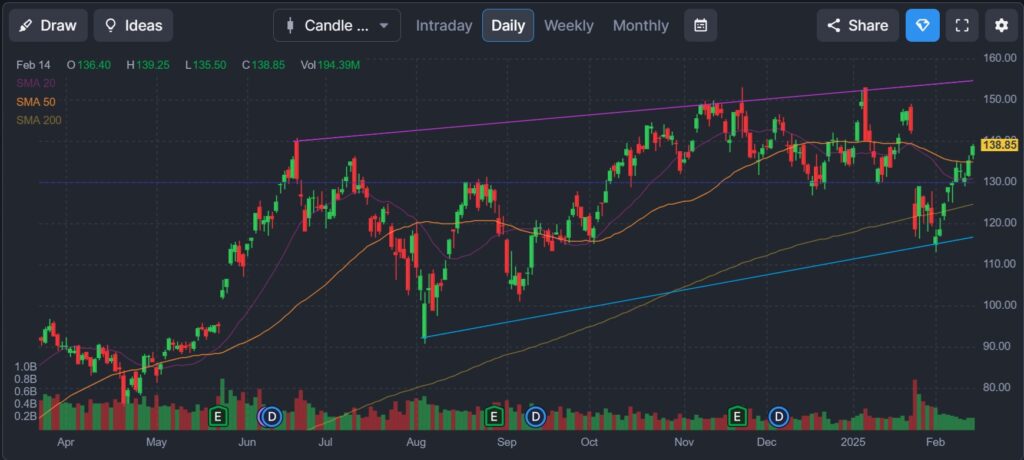Introduction
NVIDIA (NVDA) is a global leader in graphics processing units (GPUs) and system-on-a-chip (SoC) solutions. Best known for powering advanced gaming and artificial intelligence (AI) workloads, NVIDIA has successfully expanded into data centers, automotive AI, and other high-growth industries. As AI and high-performance computing become increasingly central to modern technology, NVIDIA’s strategic positioning in these sectors continues to capture investor interest.
Financial Performance
- Revenue Growth: NVIDIA has consistently posted solid revenue gains, primarily driven by the Data Center and Gaming segments. While gaming can be cyclical, the Data Center segment benefits from ongoing demand for AI, cloud computing, and big data analytics.
- Earnings Trend: Despite macroeconomic headwinds in the broader semiconductor market, NVIDIA has maintained robust earnings, with management often guiding for sustained growth in key business areas.
- Cash Flow: Strong operating cash flow has enabled NVIDIA to invest heavily in research and development, fueling the innovation that underpins its competitive edge.
Key Highlights
- AI Leadership: NVIDIA’s GPUs and software ecosystem (such as CUDA) have become indispensable for AI training and inference, securing a dominant position in a rapidly expanding market.
- Diversified Portfolio: Beyond gaming, NVIDIA’s reach extends to autonomous vehicles, robotics, healthcare, and data analytics. This diversification helps mitigate the impact of cyclical downturns in any one segment.
- Strategic Partnerships: Collaborations with major cloud service providers and enterprise clients bolster NVIDIA’s reputation and expand its customer base.
Profitability and Valuation

- High Margins: NVIDIA’s gross margins often exceed those of many semiconductor peers, reflecting its premium product lineup and pricing power.
- Premium Valuation: The stock typically trades at higher valuation multiples (P/E, P/S) relative to industry averages. Investors pay a premium for NVIDIA’s potential in AI, data center, and other growth markets.
- Return on Capital: The company’s strong ROE and ROIC underscore efficient capital deployment, validating the premium investors are willing to pay.
Debt and Leverage
- Conservative Balance Sheet: NVIDIA carries manageable levels of long-term debt, well-supported by healthy cash flows.
- Liquidity Position: Substantial cash reserves and marketable securities offer flexibility for strategic acquisitions and ongoing R&D investments.
- Debt Ratios: Metrics such as debt-to-equity remain moderate, indicating a balanced approach to financing growth while keeping leverage risks in check.
Growth Prospects
- Data Center Expansion: AI workloads continue to proliferate across industries, driving persistent demand for high-performance GPUs.
- Gaming Recovery and Innovation: While the gaming segment can face cyclical fluctuations, new product launches and increased interest in high-end gaming hardware often spark upgrade cycles.
- Automotive and Edge AI: NVIDIA’s DRIVE platform and edge computing solutions target autonomous vehicles and IoT devices—sectors with vast long-term potential.
- Software Ecosystem: Proprietary frameworks like CUDA and AI libraries lock developers into NVIDIA’s ecosystem, fostering recurring hardware demand.
Technical Analysis
Recent Price Action
Referencing the provided chart (spanning roughly from spring of last year to early 2025):
- Rising Channel: Two main trend lines are visible—an upper (purple) trend line connecting the peaks around the $150–$160 range, and a lower (blue) trend line connecting higher lows near $110–$120. This channel suggests a medium-term uptrend.
- Moving Averages: The 50-day, 100-day, and 200-day simple moving averages (SMAs) all slope upward, with the stock currently trading around $138. A bullish posture is reinforced when price remains above these SMAs.
- Support & Resistance:
- Support: The lower (blue) trend line near $110–$120 has acted as a strong support zone during market pullbacks.
- Resistance: The purple line near $150–$160 represents a potential ceiling where the stock has historically encountered selling pressure.
- Volume Patterns: Upward price moves often occur with higher volume, indicating institutional buying. Pullbacks on lower volume suggest weaker selling pressure.
Overall, the technicals point to a sustained uptrend, with the stock currently in the mid-range of its ascending channel.
Potential Catalysts
- Earnings Surprises: Positive quarterly reports, especially driven by data center strength, can propel share price momentum.
- Product Announcements: Launches of next-generation GPUs or AI-focused solutions frequently trigger renewed investor enthusiasm.
- Strategic Acquisitions: Targeted acquisitions of emerging tech companies can expand NVIDIA’s market share and product capabilities.
- Industry Partnerships: Deeper integrations with cloud providers or enterprise software firms can broaden the adoption of NVIDIA’s technologies.
Leadership and Strategic Direction
Under the visionary leadership of CEO Jensen Huang, NVIDIA has transformed from a gaming-centric GPU manufacturer to a holistic platform company. Key elements of its strategy include:
- Relentless R&D: A significant portion of revenue is reinvested in research and development, fostering cutting-edge innovations.
- Market Diversification: Expanding beyond gaming into AI, automotive, and data center ensures multiple revenue streams.
- Ecosystem Approach: NVIDIA’s software platforms and frameworks (e.g., CUDA, TensorRT) create a moat that encourages ongoing hardware demand.
Impact of Macroeconomic Factors
While NVIDIA’s secular growth story is compelling, macro factors can influence near-term performance:
- Interest Rates: Rising rates can tighten enterprise spending budgets, potentially slowing large-scale data center upgrades.
- Supply Chain Constraints: Semiconductor shortages or logistical disruptions could cap production capacity, impacting sales volumes.
- Economic Cycles: A global recession might dampen consumer spending on gaming hardware and delay enterprise capital expenditures.
Nonetheless, NVIDIA’s robust balance sheet and diversified business model often mitigate the full impact of these headwinds.
Total Addressable Market (TAM)
NVIDIA’s TAM continues to expand, spanning multiple high-growth industries:
- AI and Machine Learning: Rapidly growing as organizations automate tasks and seek advanced analytics.
- Cloud Computing: Major cloud service providers rely on GPUs for virtual machines, AI, and data analytics.
- Gaming and Esports: A large, dedicated consumer base drives consistent demand for high-performance GPUs.
- Autonomous Vehicles and Robotics: A nascent but potentially massive market as automation technologies evolve.
Given these diverse segments, NVIDIA’s growth potential remains robust over the long term.
Market Sentiment and Engagement
Market sentiment around NVIDIA is predominantly bullish:
- Analyst Ratings: Many analysts maintain buy or outperform ratings, reflecting optimism about AI-driven revenue growth.
- Institutional Ownership: Mutual funds, pension funds, and hedge funds often include NVIDIA as a core holding in their tech portfolios.
- Social Media Chatter: Retail investor forums and social media platforms frequently highlight NVIDIA’s role in cutting-edge technologies, sustaining retail interest.
Conclusion
NVIDIA’s fusion of innovative product development, strategic leadership, and strong financial metrics underpins its long-term investment appeal. Despite potential volatility stemming from macroeconomic factors, the company’s focus on AI, data center expansion, and an entrenched ecosystem suggests room for further upside.
Target Price Objectives
Over the next 12–18 months, a target price range of $180 to $210 appears plausible. This projection assumes continued AI adoption, data center demand, and stable macro conditions that support enterprise spending.
Stop-Loss Recommendation
Given the stock’s historical volatility and premium valuation, a stop-loss around 10–12% below the current market price is advisable. This approach balances risk management with the potential for continued gains in a market that rewards innovation and growth.
DISCOVER MORE
For more insights into analyzing value and growth stocks poised for sustainable growth, consider this expert guide. It provides valuable strategies for identifying high-potential value and growth stocks.
We also have other highly attractive stocks in our portfolios. To explore these opportunities, visit our investment portfolios: bit.ly/3Y9Bt0g









0 Comments